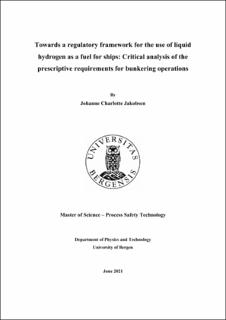| dc.description.abstract | The global demand for energy increases rapidly with the growth in the population and a steady increase in the general standard of living. At the same time, the consumption of fossil fuels causes massive releases of greenhouse gases (GHG) that influence the global climate. Hence, the global energy mix needs a shift towards increasing use of renewable energy sources and sustainable use of conventional fuels. In this perspective, various energy forecasts and strategies outline a future where hydrogen and hydrogen-based fuels (including ammonia) will play an important role as an energy carrier in industry and society. In various parts of the maritime sector, liquid hydrogen (LH2) can replace conventional fuels such as liquid natural gas (LNG) and marine fuel oils. Provided enough hydrogen can be produced from renewable sources, or from fossil fuels with carbon capture, it will be possible to reduce the GHG emissions from maritime transport significantly. However, a comparison of critical safety-related properties of different fuels shows that it is not straightforward to achieve the same level of safety for hydrogen systems, compared to conventional fuels. Compared to LNG, LH2 has significantly lower storage temperature, much lower minimum ignition energy (MIE), significantly wider flammable range, and much higher reactivity. Of particular importance for safety distances related to fuel storage facilities and bunkering operations is the propensity of hydrogen-air mixtures to undergo deflagration-to-detonation-transition (DDT) under specific conditions. In summary, this implies a need for a different approach to safety engineering, including the methods used for estimating safety zones for bunkering operations. On the other hand, the low density and enthalpy of vaporisation of hydrogen imply that accidental releases in the open often will be dominated by buoyancy, which would be favourable from the point of view of safety. Experimental data from large-scale releases of LH2 in the open are scarce. However, in 2019 the Norwegian Public Roads Administration (NPRA) and the Norwegian Defence Research Establishment (FFI) commissions a series of controlled release and dispersion experiments with LH2 from DNV GL. The experiments, performed at the large-scale test site at Spadeadam, included seven outdoor tests representative of accident scenarios during bunkering operations. The data from the tests document the size, shape and behaviour of the dispersed clouds generated for specific tank pressures, outflow rates, and weather conditions. This thesis explores safety challenges for bunkering operations and other operations involving transfer of LH2 between or from cryogenic storage units. The aim is to provide science-based recommendations for relevant regulations, codes and standards (RCS). The approach adopted entails numerical simulations of the DNV GL experiments, to build confidence in the predictive capabilities of the computational fluid dynamics (CFD) tool FLACS developed by Gexcon. The FLACS software is then used to simulate hypothetical accident scenarios involving LH2. The simulations focus on the formation and duration of flammable gas clouds near ground, without ignition. The analysis includes a sensitivity study to explore the relative effect of selected parameters on the size and shape of the dispersion clouds. Finally, the results from the simulations are used to evaluate prescriptive requirements for LH2 bunkering operations in the International Code of Safety for Ships using Gases or other Low-flashpoint Fuels (IGF Code) from the International Maritime Organisation (IMO) and other relevant RCS. Notably, the IGF Code only applies to the ship, including onboard bunkering stations, while standards such as Ships and marine technology – Specification for bunkering of liquefied natural gas fuelled vessels (ISO 20519) from the International Organization for Standardization (ISO) applies to onshore bunkering operations in ports and harbours. The results from both experiments and simulations show that parameters such as wind velocity, release rate, release direction and outdoor temperature have significant impact on the dispersed cloud. However, for similar conditions, a release of LH2 extends further than a release of LNG, compared to earlier studies of LNG releases. Considering the ignition sensitivity and significantly higher reactivity, including the propensity for DDT, for hydrogen compared to methane, it is clear that releases of LH2 are more hazardous compared to releases of LNG. Hence, to achieve the same level of safety, assuming similar leak rates and leak frequencies, the safety distances, or safety zones, should be increased significantly in the case of LH2, compared with LNG. | |
